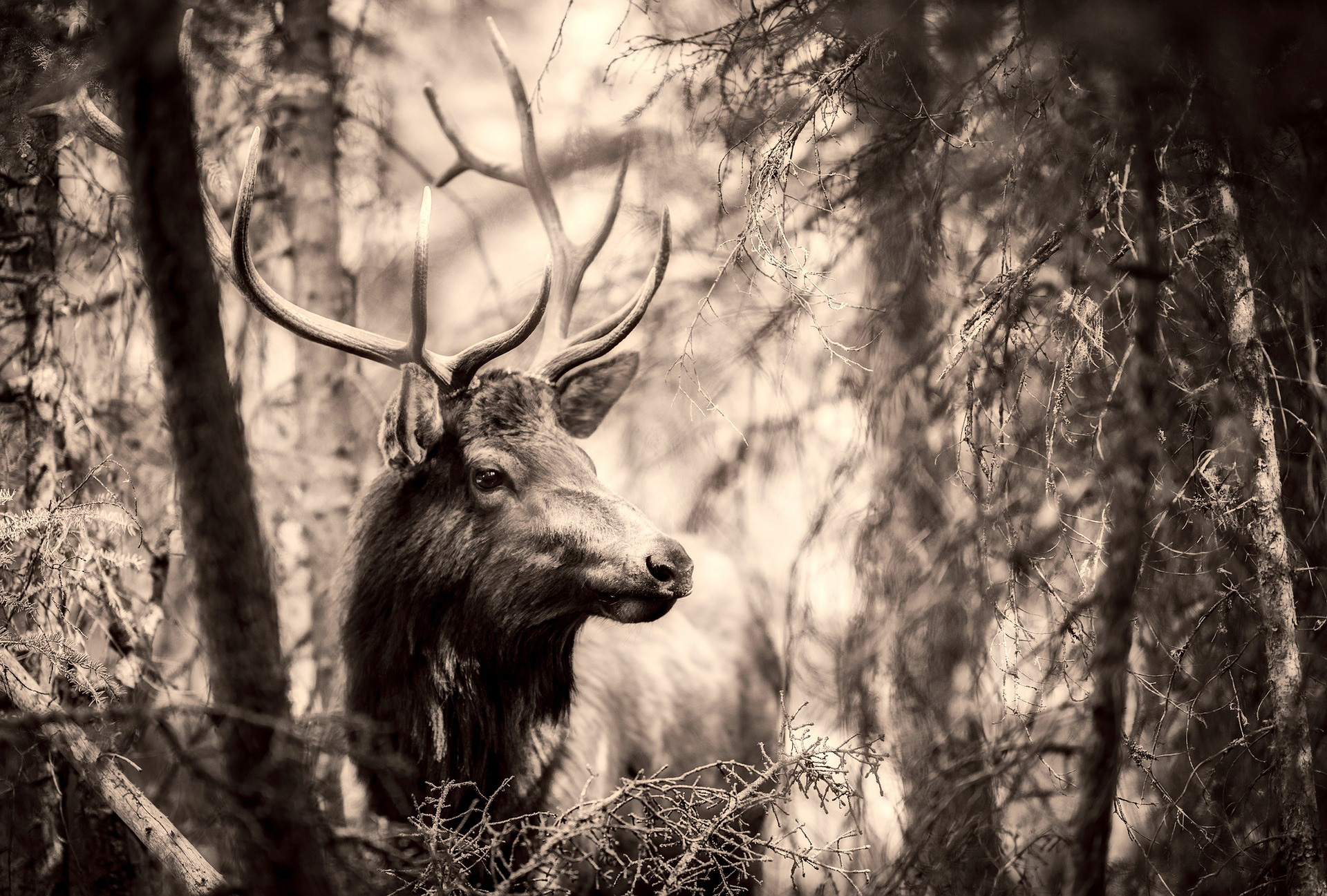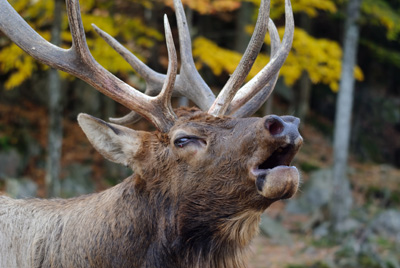
Patience is a virtue, so they say. But is it one of your elk tactics? Should it be?
The early morning light reflected the bull’s respectable antlers as he followed his cows. They were climbing the ridge from the canyon bottom where they had fed all night. I had patterned the elk in this throughout the hunt, and knew there was a good chance they would follow that ridge to their bedding area. Crossing the sage covered canyon bottom, I climbed the ridge. I looked for an ambush spot that would give me an opportunity.
A natural bottleneck where the ridge top narrowed and the pine trees were very thick seemed ideal. One side of the ridge dropped off in a steep tangle of oak brush. The other side dropped off into the canyon the elk had just left. Undisturbed elk will usually take the easiest route to get to their destination. I knew that it was likely the elk would go around the thicket of trees and brush, but stay on this narrow ridge top. The thick vegetation provided great cover, and there was a slight depression in the terrain allowing me to stay even more hidden. And most important, the wind was in my face as long as the elk followed the path that I expected.
After about 10 minutes of waiting and a few steps up the hill to peer through the brush, I saw the lead cow coming up the ridge. She was perfectly following the script I had written in my head. Dropping back into the low spot on the ridge, I waited in the shadows. In a few more minutes, the cow’s inquiring nose appeared from behind a small pine, 30 yards away, just as I expected. 30 yards was a high confidence shot with my bow, even for a novice archer like me. The cow was oblivious. She had no idea that danger lurked quietly in the oak brush of her back yard.
Even though my tag was good to harvest an elk of either sex, given the choice I would take a bull. My heart pounded as I watched the cow slowly cross through the shooting lane I had cleared. Soon another cow, and yet another. The foliage at the elk crossing was low enough that I should be able to see the bull’s antlers before he came into the open. That would allow me to draw my bow unseen. I waited.
And waited. The bull had bugled to his cows several times during his trek up the ridge, but he had been silent for some time now. Where was he? Was he still following his cows? Did he choose some other trail that led to his bed? Did something distract him or spook him away? The adrenaline running through my veins made me imagine all sorts of possibilities.
As I waited, I spied a small tree that was about 10 yards closer to the path the cows had taken. It would provide good cover and be closer. It was also somewhat higher and would allow me to see down the ridge to determine if the bull was on his way. I made my move. But before I reached the cover of my destination, antlers appeared above the brush, and I saw an eye peering my way.
The bull whirled and crashed through the woods as he quickly disappeared. If I had only waited one more minute in my original hiding spot! The bull would have waltzed through my shooting lane and probably given me a shot opportunity.
The old adage goes that “Patience is a Virtue”. Sometimes patience can also mean success when it comes to elk tactics. But sometimes it’s best to not be patient, but to do something totally different. The key is determining the right time to follow the right approach.
Patience
The Oxford English dictionary defines patience as “the capacity to accept or tolerate delay, trouble, or suffering without getting angry or upset”. In the context of elk tactics, here are three scenarios where patience is required.
Ambush
Whether I am set up in a tree stand, a commercial or natural ground blind, or simply a good a spot to hide, it’s best to be patient and let the elk come to me. That’s assuming that I have done my homework and identified a good spot for my ambush. What is attracting the elk to that spot? Food? Water? Cover? Calls? Do elk pass through this spot moving to or from their bedding grounds? Have I seen elk in this spot recently? Are there fresh elk tracks indicating that elk are frequenting this spot? When I was hunting on top of that ridge, I couldn’t have asked for a better ambush location. I just wasn’t patient enough for that bull to come through.
Glassing
Using a spot and stalk method of elk hunting, a hunter must obviously “spot” an elk before he can stalk him. Locating elk with binoculars or a spotting scope requires patience. When I have found a vantage point that provides a view of a large area that is likely to contain elk, two things that help me be patient are comfort and being methodical.
I hate being cold. The best spots to glass from are high peaks or ridge lines. In those locations there is often a cold wind blowing, particularly in late season hunts. This is why I always dress in layers. Climbing the mountain will generate large amounts of body heat, which will cause perspiration. I try to minimize the buildup of heat and resulting moisture by shedding outer layers of clothing. When I reach the high point and settle down to glass, I can put the layers back on to stay comfortable.
The method I use to glass for elk is a quick scan across my field of view to see if there is anything obvious that I can’t see with the naked eye. Then I use a grid pattern, left to right and top to bottom, covering every square inch, taking a very close look at everything that could possibly hold an elk. If I come up empty, I start the process all over again. Quick Scan. Detailed Grid. There are probably many methods that can be used to glass for elk, but the critical thing is to have a method. This helps me to stay focused and ultimately helps me to be patient.
Stalking
One of the most difficult times for me to be patient while elk hunting is when I am stalking. Sometimes it is important to close the distance quickly between the elk and me. As a bow hunter, I have to get very close to an elk to get a shot. Many times I have moved slowly and quietly to a spot where I had seen an elk, only to arrive and find that the elk has disappeared. Usually the reason is that elk are constantly moving. Unless they are bedded down, they don’t stay in one place for long.
If I see an elk at a distance, I will try to move as quickly as possible to get close to the elk. I will take advantage of terrain, vegetation, and the wind direction to avoid detection. It’s critical to not be seen, but silence is not as important. I just do the best I can to move quietly but quickly. When I get within 100 yards, or I actually have the elk in sight, then I slow down and practice patience. The closer I get, the more likely it is that the elk will hear me, or another elk will see my movement and they will all disappear with a disappointing crash. When I am very close, the temptation is to quickly move into position to get a shot, but patience is critical.
Patience or Pull Out?
Sometimes patience is NOT one of the elk tactics to use, it can actually be detrimental to a hunter’s chances for success.
In 2015 my youngest son drew a youth-only rifle elk tag in a great unit. The timing of this either sex hunt was in the peak of the rut and his was only one of 25 tags in the entire unit for the hunt. Following a tip on where we might find some elk with low hunting pressure, we showed up and began scouting the area a couple of days before the hunt. But despite covering lots of country via truck, ATV and foot, we had only seen a glimpse of one cow elk. We crossed a small number of fresh tracks, and heard no bugles whatsoever. It was 2 days into a 5 day hunt and we had to decide, should we be patient and try to find one of the few elk in the area? Or, should we pull out and move to a completely different part of the unit? We chose the latter. There were more elk, and more hunters, but on the last day of the hunt my son harvested a small bull with 30 minutes of the hunt left.
We were glad that we weren’t patient. If I am not seeing elk or fresh elk sign where I am hunting, I am going to find another spot to hunt if at all possible. It doesn’t matter how “elky” the terrain may be, or if there is great food, water and shelter for the elk. If they aren’t there I’m not going to patiently wait for them.
Patience or Push?
When guiding for an outfitter on a ranch in southern Colorado, we had a late season hunt that was not yielding results. The elk were definitely there, but they had gone completely nocturnal. Getting into the woods long before daylight and staying until the last legal light, we weren’t seeing elk. But the ample amounts of fresh droppings in the meadows told us that the elk were there. They were just avoiding us by moving to the dark timber long before light and not coming out until well after dark.
We decided to do an elk drive. We positioned our hunters on a few good vantage points and noisily moved into the dark timber to push the elk toward the hunters. It worked. A couple of bulls were harvested that day. While I would normally not recommend purposely moving into the elk’s bedding area as one of your elk tactics, patience may not be the best option if you are running out of time.
Conclusion
Slow down or hurry up? Patience, pull out, or push? Sometimes the answer isn’t clear. But I’ve learned to try and weigh the information I have, and do my best to objectively determine the best elk tactics to deploy. I ask myself: “What will the elk do?”. While I may not always be right, being patient or not at the right time has helped me get more opportunities and elk encounters.
Latest posts by Jimmie Norris (see all)
- Elk Hunting Gear Essentials – Radios - April 26, 2020
- Elk Hunting Gear Essentials – Binoculars - February 9, 2020
- Elk Hunting Gear Essentials – GPS - January 19, 2020
- Best Camo Pattern for Elk Hunting - December 1, 2019
- Elk Hunt 2019 Part 2 - November 3, 2019




